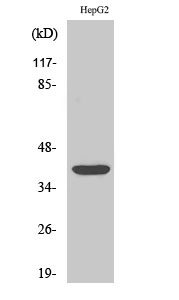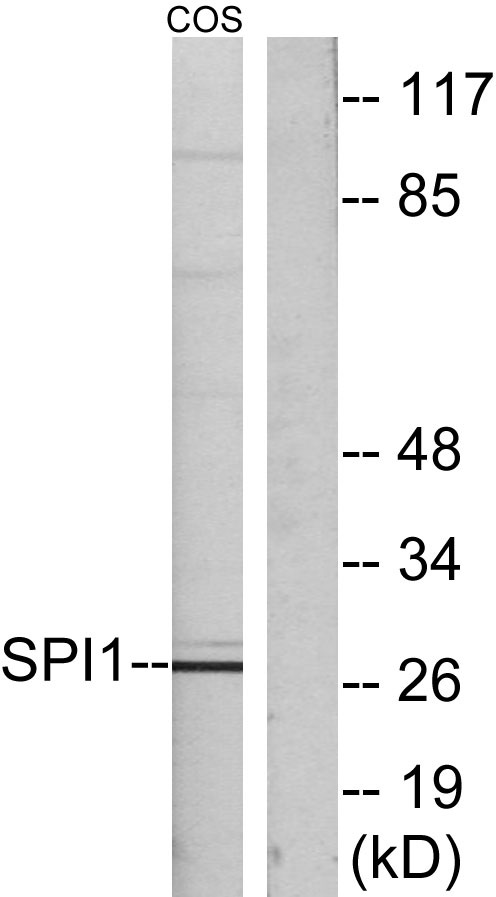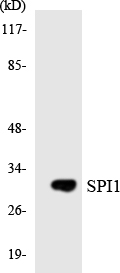PU.1 Polyclonal Antibody
- Catalog No.:YT3906
- Applications:WB;IHC;IF;ELISA
- Reactivity:Human;Mouse;Rat;Monkey
- Target:
- PU.1
- Fields:
- >>Osteoclast differentiation;>>Human T-cell leukemia virus 1 infection;>>Pathways in cancer;>>Transcriptional misregulation in cancer;>>Acute myeloid leukemia
- Gene Name:
- SPI1
- Protein Name:
- Transcription factor PU.1
- Human Gene Id:
- 6688
- Human Swiss Prot No:
- P17947
- Mouse Gene Id:
- 20375
- Mouse Swiss Prot No:
- P17433
- Rat Gene Id:
- 366126
- Rat Swiss Prot No:
- Q6BDS1
- Immunogen:
- The antiserum was produced against synthesized peptide derived from human SPI1. AA range:181-230
- Specificity:
- PU.1 Polyclonal Antibody detects endogenous levels of PU.1 protein.
- Formulation:
- Liquid in PBS containing 50% glycerol, 0.5% BSA and 0.02% sodium azide.
- Source:
- Polyclonal, Rabbit,IgG
- Dilution:
- WB 1:500 - 1:2000. IHC 1:100 - 1:300. IF 1:200 - 1:1000. ELISA: 1:40000. Not yet tested in other applications.
- Purification:
- The antibody was affinity-purified from rabbit antiserum by affinity-chromatography using epitope-specific immunogen.
- Concentration:
- 1 mg/ml
- Storage Stability:
- -15°C to -25°C/1 year(Do not lower than -25°C)
- Other Name:
- SPI1;Transcription factor PU.1;31 kDa-transforming protein
- Observed Band(KD):
- 32kD
- Background:
- This gene encodes an ETS-domain transcription factor that activates gene expression during myeloid and B-lymphoid cell development. The nuclear protein binds to a purine-rich sequence known as the PU-box found near the promoters of target genes, and regulates their expression in coordination with other transcription factors and cofactors. The protein can also regulate alternative splicing of target genes. Multiple transcript variants encoding different isoforms have been found for this gene. [provided by RefSeq, Jul 2008],
- Function:
- function:Binds to the PU-box, a purine-rich DNA sequence (5'-GAGGAA-3') that can act as a lymphoid-specific enhancer. This protein is a transcriptional activator that may be specifically involved in the differentiation or activation of macrophages or B-cells. Also binds RNA and may modulate pre-mRNA splicing.,induction:Highly expressed in both FV-P and FV-A-induced erythro-leukemia cell lines that have undergone rearrangements of the Spi-1 gene due to the insertion of SFFV.,similarity:Belongs to the ETS family.,similarity:Contains 1 ETS DNA-binding domain.,subunit:Binds DNA as a monomer. Interacts with RUNX1 and SPIB. Interacts with CEBPD and NONO.,
- Subcellular Location:
- Nucleus .
LINC00998 Modulating M2 Macrophage Activation in Allergic Rhinitis by Stabilizing BOB.1 mRNA Journal of Inflammation Research Yan He WB Human 1:1000 THP-1 cell,HEK293T cell
- June 19-2018
- WESTERN IMMUNOBLOTTING PROTOCOL
- June 19-2018
- IMMUNOHISTOCHEMISTRY-PARAFFIN PROTOCOL
- June 19-2018
- IMMUNOFLUORESCENCE PROTOCOL
- September 08-2020
- FLOW-CYTOMEYRT-PROTOCOL
- May 20-2022
- Cell-Based ELISA│解您多样本WB检测之困扰
- July 13-2018
- CELL-BASED-ELISA-PROTOCOL-FOR-ACETYL-PROTEIN
- July 13-2018
- CELL-BASED-ELISA-PROTOCOL-FOR-PHOSPHO-PROTEIN
- July 13-2018
- Antibody-FAQs
- Products Images

- Western Blot analysis of various cells using PU.1 Polyclonal Antibody cells nucleus extracted by Minute TM Cytoplasmic and Nuclear Fractionation kit (SC-003,Inventbiotech,MN,USA).

- Immunohistochemical analysis of paraffin-embedded Human brain. Antibody was diluted at 1:100(4° overnight). High-pressure and temperature Tris-EDTA,pH8.0 was used for antigen retrieval. Negetive contrl (right) obtaned from antibody was pre-absorbed by immunogen peptide.

- Western blot analysis of lysates from COS7 cells, using SPI1 Antibody. The lane on the right is blocked with the synthesized peptide.

- Western blot analysis of the lysates from HUVECcells using SPI1 antibody.


